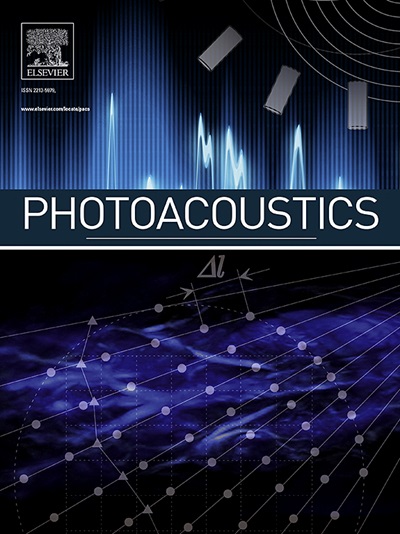In vivo 3D photoacoustic and ultrasound analysis of hypopigmented skin lesions: A pilot study
IF 7.1
1区 医学
Q1 ENGINEERING, BIOMEDICAL
引用次数: 0
Abstract
Vitiligo needs early identification for proper intervention. Current adjunct diagnostic methods rely mostly on subjective visual inspection. Thus, identification of early or atypical vitiligo lesions among other hypopigmentation disorders may pose challenges. To overcome this, we investigate the feasibility of a three-dimensional (3D) photoacoustic (PA) and ultrasound (US) imaging technique as a new adjuvant analytic tool providing quantitative characterization of hypopigmentation features. This cross-sectional study was conducted at Seoul St. Mary’s Hospital (Seoul, Republic of Korea) between August 2022 and January 2024. Lesions diagnosed vitiligo or IGH in locations that could safely be irradiated with laser were analyzed with 3D PA/US imaging along with the conventional diagnostic methods. A total of 53 lesions consisted of 36 vitiligo lesions and 17 IGH lesions from 39 participants with confirmed diagnosis were analyzed. The PA amplitude greatly differed between normal skin and hypopigmentation lesions, and the mean PA amplitudes of vitiligo lesions were slightly higher than that of IGH [mean (standard deviation, SD): vitiligo: 0.117 (0.043); IGH: 0.135 (0.028)]. The local SD of the PA amplitude were higher in IGH than in vitiligo lesions [vitiligo: 0.043 (0.018); IGH: 0.067 (0.017)]. The mean PA slope across the lesion boundary was significantly higher in IGH than in vitiligo [vitiligo: 0.173 (0.061); IGH: 0.342 (0.099)], whereas the PA peak depth was deeper in vitiligo than in IGH [vitiligo: 0.568 (0.262); IGH: 0.266 (0.116)]. Unlike conventional qualitative methods, 3D PA/US imaging can non-invasively provide quantitative metrics which might aid in the differentiation of vitiligo from IGH lesions.
低色素皮肤病变的体内三维光声和超声分析:一项初步研究
白癜风需要早期识别以进行适当的干预。目前的辅助诊断方法主要依靠主观视觉检查。因此,鉴别早期或非典型白癜风病变与其他色素沉着障碍可能会带来挑战。为了克服这一点,我们研究了三维(3D)光声(PA)和超声(US)成像技术作为一种新的辅助分析工具的可行性,提供了色素沉着特征的定量表征。这项横断面研究于2022年8月至2024年1月在首尔圣玛丽医院(韩国首尔)进行。在常规诊断方法的基础上,对可安全接受激光照射的白癜风或IGH病变进行三维PA/US成像分析。总共53个病变,包括36个白癜风病变和17个IGH病变,来自39名确诊的参与者。正常皮肤与低色素沉着病变的PA振幅差异较大,白癜风病变的PA振幅平均值略高于IGH[平均值(标准差,SD):白癜风:0.117 (0.043);高:0.135(0.028)]。白癜风病变PA振幅的局部SD值高于白癜风病变[白癜风:0.043 (0.018);[0.067(0.017)]。白癜风:0.173(0.061);白癜风:0.173 (0.061);IGH: 0.342(0.099)],白癜风的PA峰深度比IGH深[白癜风:0.568 (0.262)];Igh: 0.266(0.116)]。与传统的定性方法不同,3D PA/US成像可以无创地提供定量指标,这可能有助于白癜风与IGH病变的区分。
本文章由计算机程序翻译,如有差异,请以英文原文为准。
求助全文
约1分钟内获得全文
求助全文
来源期刊

Photoacoustics
Physics and Astronomy-Atomic and Molecular Physics, and Optics
CiteScore
11.40
自引率
16.50%
发文量
96
审稿时长
53 days
期刊介绍:
The open access Photoacoustics journal (PACS) aims to publish original research and review contributions in the field of photoacoustics-optoacoustics-thermoacoustics. This field utilizes acoustical and ultrasonic phenomena excited by electromagnetic radiation for the detection, visualization, and characterization of various materials and biological tissues, including living organisms.
Recent advancements in laser technologies, ultrasound detection approaches, inverse theory, and fast reconstruction algorithms have greatly supported the rapid progress in this field. The unique contrast provided by molecular absorption in photoacoustic-optoacoustic-thermoacoustic methods has allowed for addressing unmet biological and medical needs such as pre-clinical research, clinical imaging of vasculature, tissue and disease physiology, drug efficacy, surgery guidance, and therapy monitoring.
Applications of this field encompass a wide range of medical imaging and sensing applications, including cancer, vascular diseases, brain neurophysiology, ophthalmology, and diabetes. Moreover, photoacoustics-optoacoustics-thermoacoustics is a multidisciplinary field, with contributions from chemistry and nanotechnology, where novel materials such as biodegradable nanoparticles, organic dyes, targeted agents, theranostic probes, and genetically expressed markers are being actively developed.
These advanced materials have significantly improved the signal-to-noise ratio and tissue contrast in photoacoustic methods.
 求助内容:
求助内容: 应助结果提醒方式:
应助结果提醒方式:


